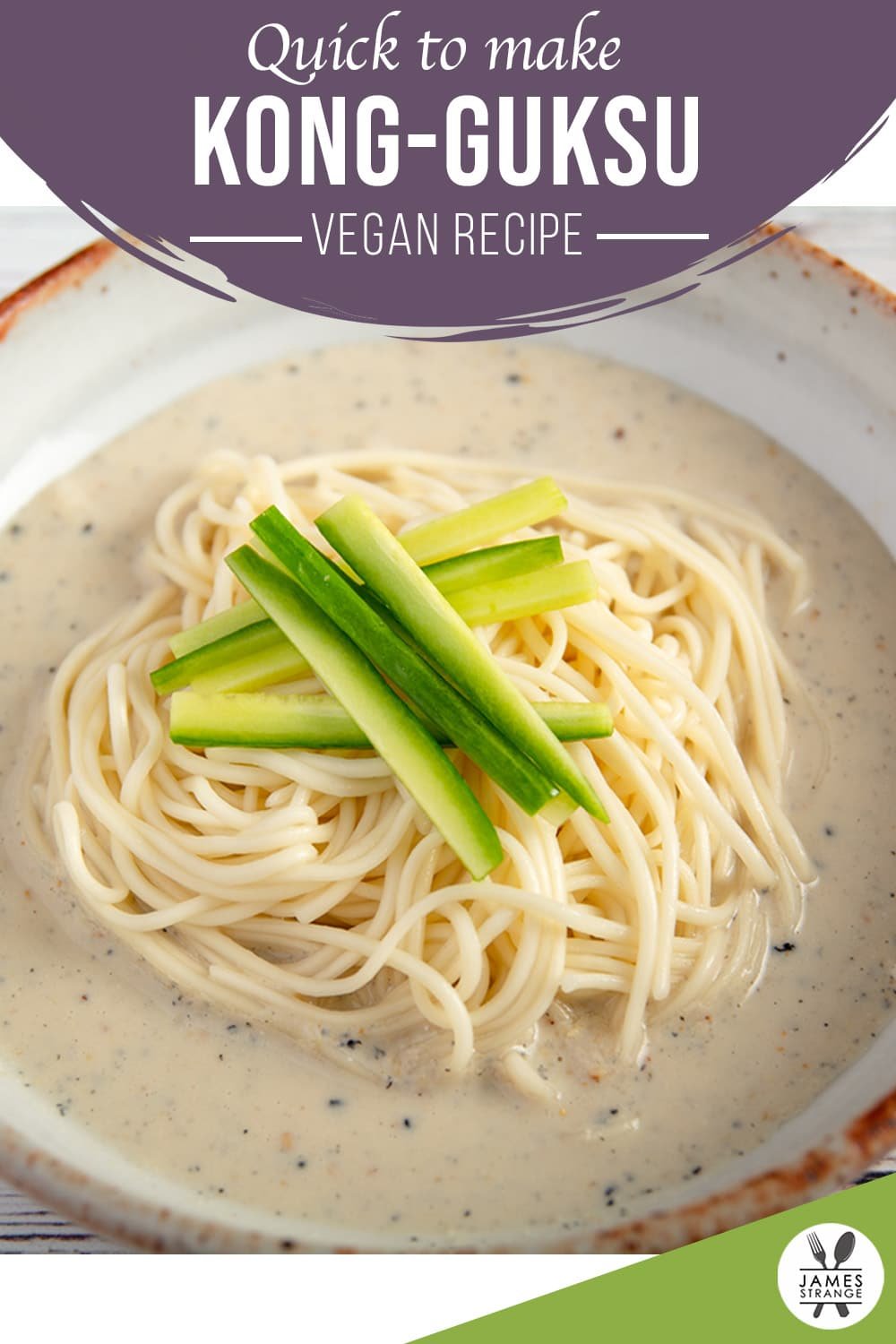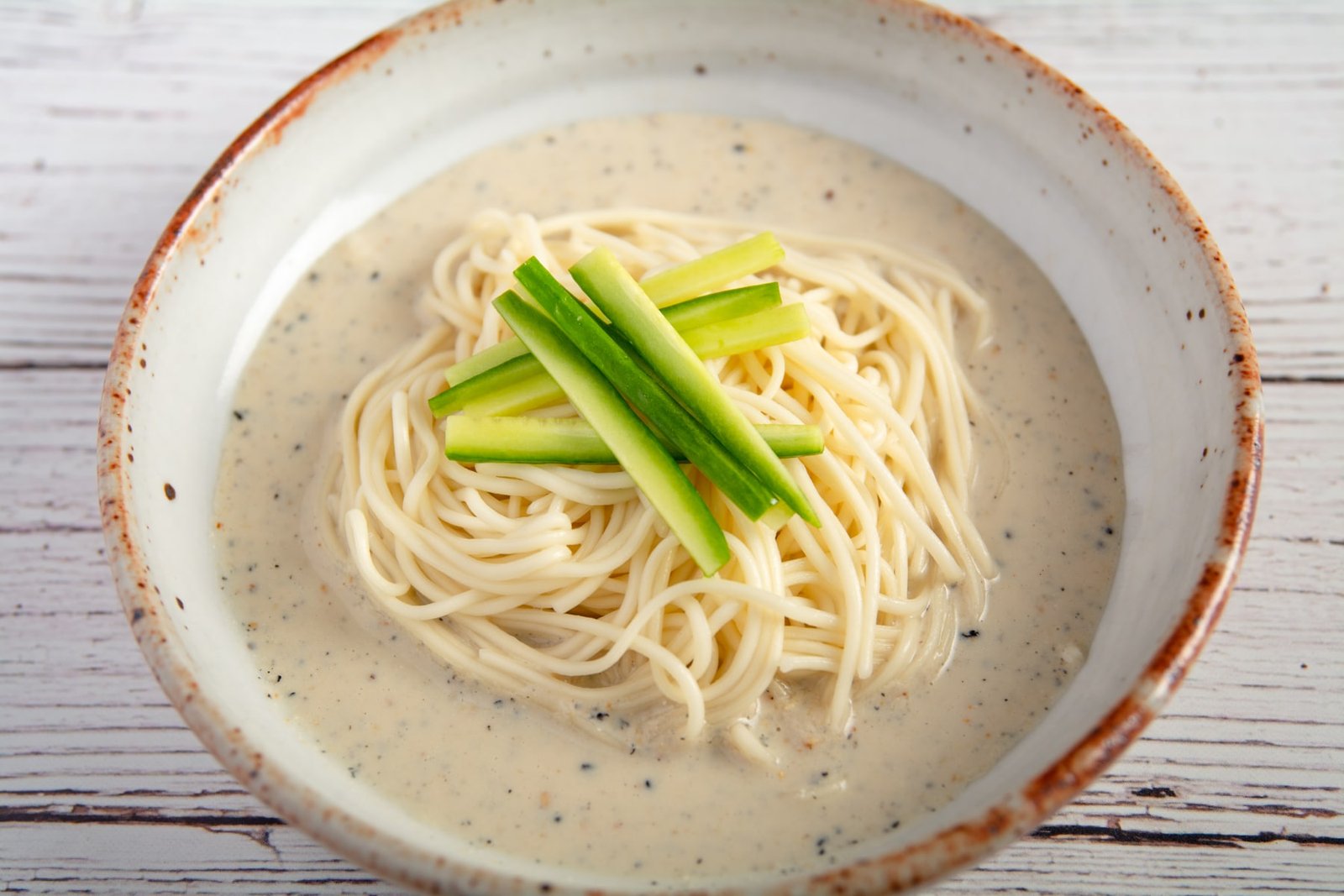Sunshine streaming, birds chirping…the only thing missing from this perfect summer day is a cool bowl of something refreshingly delicious. Cue the Kong-guksu, the Korean cold noodle soup that sends shivers (the good kind!) down your spine with every slurp. But wait, hold the phone! Don’t let visions of hours spent simmering broth have you running for the hills (or the ice cream truck). Today, we’re taking this culinary gem on a shortcut spree, transforming it into a tofu-tastic, time-saving masterpiece that’ll keep your cool without sacrificing any of that authentic, lip-smacking flavor.
Kong-guksu or Korean thin noodles in soy milk soup is a delicious and refreshing way to cool off in the hot summertime. But making soy milk takes a long time and lots of work to make. So the dish is usually consumed outside of the home. This recipe is a hack to quickly and easily make a dish almost as good as what you would buy in the markets. This recipe can be made in about thirty minutes.

Picture this: sunbeams dancing on colorful silks, the murmur of haggling blending with sizzling street food scents. We were at Namdaemun market, wallets in hand, eyes wide with wanderlust. Traditional dresses twirled, cookware sparkled, and mushroom mountains (seriously, who knew there were so many kinds?!) threatened to topple over in a rainbow cascade.
Hairtail Alley beckoned next, its aroma of braised beltfish (a Korean delicacy) twisting my stomach. Sadly, gout put that fishy treat firmly off-limits. Just then, my eagle-eyed wife spotted a beacon of hope: “Kong-guksu!” she cried, and like a noodle-fueled superhero, we dove in.
Vegetarians, brace yourselves. Ordering vegan in Korea can be a minefield. Kimchi? Might have anchovies hiding. Side dishes? Shellfish ambush potential. This kong-guksu, however, promised veggie nirvana. Except…wait, an egg? Turns out, in Korea, vegetarian sometimes includes broth made with animal products (who knew?). No worries, a quick negotiation later, and eggy peril averted!
While devouring our chilled noodle bliss, we struck up a conversation with the owner. Turns out, this lady’s dedication to taste was legendary. Every day, she crafted her own soy milk from scratch, soaking soybeans at dawn, grinding and simmering through the afternoon, and infusing it with secret sesame magic overnight. By lunchtime, her creamy concoction was ready to cool down Seoul’s hungry souls.
Now, I’m no soy milk alchemist myself, but thanks to this recipe, homemade kong-guksu glory awaits! Maybe it won’t top Namdaemun magic, but hey, thirty minutes of slurpy satisfaction ain’t bad, right? So grab your chopsticks, crank up the K-pop, and let’s bring a taste of Seoul to your kitchen!

Ingredients for Shortcut Kong-guksu:
Noodles: Time to deck out our dish with some yummy strands! I’m a big fan of thin, dried noodles myself, they slurp up that sauce like nobody’s business. But hey, this party is all about you! Throw in whatever noodles tickle your fancy, thick, thin, curly, straight – the choice is yours! Let’s get those noodley vibes flowing!
Tofu: Tofu adds a beautiful silkiness to the broth, creating a velvety texture that makes every slurp a pure delight. Imagine the noodles gliding seamlessly through a cloud of creamy goodness – bliss!
Peanut butter: Peanut butter contains natural glutamates, which contribute to the savory, umami taste we crave in food. This can help round out the broth and make it feel more substantial, even with a simplified recipe
Sesame seeds: Sesame seeds contain natural aromatic compounds that bloom when toasted. These subtle fragrances mingle with the soy milk and broth, creating a complex and enticing aroma that draws you in before you even take a bite. It’s like your nose getting a pre-taste of the deliciousness to come!
Raw sugar: Unlike refined sugar, raw sugar retains some minerals and molasses, giving it a more complex and nuanced sweetness. This depth of flavor blends beautifully with the richness of the soy milk and the nutty aroma of sesame.
Salt: A pinch of salt isn’t just about “salty.” It adds depth and complexity to your broth, bringing out subtle layers of flavor you might not have noticed before. It’s like magic dust for your taste buds, transforming a simple dish into something truly captivating.
Plant-based milk: Depending on the plant-based milk you choose, you can add unique and interesting flavor profiles to your Kong-guksu. Oat milk adds a creaminess and subtle sweetness, while almond milk gives a lighter, nuttier taste. Experiment and find what you like!
Step 1: Noodle Party Prep!
Let’s get this noodle party started! Grab a big pot and fill it with water. Clap your hands together like a magician summoning thunder, and turn on the heat to bring that water to a rolling boil.
Step 2: Blend That Broth!
While the water is bubbling away like a happy volcano, gather your soup ingredients like the tofu troops, sesame seed squad, and peanut butter platoon. Throw them all into your trusty blender, a culinary spaceship ready to whip up a taste sensation. Blast them into a smooth and creamy broth, fit for a noodle king.
Step 3: Taste Check and Chill
Give your broth a sip, like a wise sensei testing the wisdom of her tea. If it needs a pinch of salt to sing, or maybe a spoonful of sugar to dance, add it in and blend again. Once it’s a flavor fiesta, let it chill in the fridge like a cool cat waiting for its moment to shine.
Step 4: Bowl Brigade Assemble!
While the broth awaits its destiny, gather your bowls like loyal knights and get your banchan (those delicious little side dishes) ready to party. They’ll be cheering on the noodles when they arrive!
Step 5: Noodle Nirvana!
Back to the pot! When the water is boiling like a dragon’s breath, gently drop in your noodle warriors and follow the package instructions to cook them to perfection. Remember, they’re like delicate dancers, so treat them with care!
Step 6: Cold Noodle Shock!
As the noodles twirl and twirl in their hot bath, prepare a cold shower for them. Grab a strainer and place it over a sink filled with icy water, ready to give the noodles a refreshing shock. If you’re feeling fancy, grab some ice cubes too, like sparkling diamonds for your soup.
Step 7: Noodle Cool Down and Serve!
Once the noodles are cooked, grab your strainer and carefully scoop them out, sending them straight into the cold water bath. Swish them around like they’re at a noodle disco, making sure they get all the love of the icy water. This stops them from cooking anymore, washes away any extra starch, and cools them down for their big debut.
Step 8: Souptacular Finale!
Now, the grand finale! Divide your chilled noodles between your bowls, pour over the creamy, cool broth like a magic potion, and add some ice cubes if you’re feeling extra frosty. Finally, sprinkle on your favorite garnishes like sesame seeds (little flavor bombs!), bean powder (a magical taste-changer!), or cucumber slices (cool and refreshing!).
And there you have it! A bowl of Kong-guksu that’s bursting with flavor, fit for a noodle champion. So grab your chopsticks, slurp away, and enjoy the taste of summer in every bite!

Hey there, noodle lover! If you slurped up this Kongguksu like nobody’s business, then I have another Korean treat that’ll knock your socks off: Bindetok! Think crispy, savory pancakes packed with mung bean goodness, perfect for dipping in that same dreamy sesame sauce. Trust me, your taste buds will be doing a happy dance! Want the recipe? Just click right here and get ready for another Korean food fiesta!

Hey there fellow food fan! If you whipped up this yummy recipe and it turned out a dream, I’d be super grateful if you shared it on Pinterest! ✨ Spreading the love (and the deliciousness) helps my little corner of the internet grow, and who knows, you might inspire someone else to give it a go! Thanks a bunch!

Ingredients
Noodles
- 360 Grams Noodles Preferably thin, 4 servings
Soup
- 8 oz Firm tofu
- 4 Tablespoons Sesame seeds Toasted
- 2 Tablespoons Black sesame seeds
- 3 Tablessons Peanut butter
- 1 Tablespoon Raw sugar
- 1/2 teaspoon Salt
- 3 Cups Plant based milk Unsweetened
Instructions
- Place a large pot of water on the burner and bring to a boil.
- Place all soup ingredients into a blender and blend.

- Taste the soup and adjust as necessary. Place the soup into the refrigerator until ready to use.
- Cook the noodles according to package directions and strain.
- Give the noodles a good rinse under cold water, place into bowls, add the soup and garnish.

